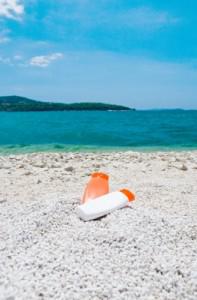
Credit
It is worrying that – according to skin experts Nivea – 40% of parents do not apply sun cream to their children when holidaying at home, instead only doing such when on a trip abroad. Protecting children’s skin from harmful rays is important whenever and wherever the sun decides to ‘put its hat on’ but knowing which product to use can be bewildering.
Many parents get confused when visiting their local pharmacy or beauty store in order to purchase sun protection creams for their kids – there are so many to choose from! But did you know that mums and dads don’t actually necessarily need to buy their children a sun cream that is different to the one they use themselves?
So long as the following advice is heeded, young children can have fun in the sun without the risk of painful burning and skin ailments later in life.
Be sure to apply sunscreen at least 20 minutes before going out in the sun too!
Sunscreens and Sunblocks: What’s the Difference?
Many people do not realize that there is variation between the different sun protection creams that are available. Some products will be labelled as ‘sunscreen’ whilst others will be labelled as a ‘sun block’.
Sunscreens comprise chemicals which absorb and alter the frequencies of UV rays (rendering them safe) whilst sun blocks work like a mirrored shield to deflect these same rays off of the skin. The main active ingredient usually found in sunscreen is PABA whilst sun blocks comprise titanium dioxide and/or zinc oxide (some lotions do contain ingredients found in both types though).
But is one type of sun barrier better than the other? No, not really; it’s more a matter of preference. Many parents with children who have sensitive skin prefer to use sun blocks since the ingredients within are less likely to cause irritation, whilst others prefer the thinner consistency of sunscreens.
Whichever sun lotion you choose, you should look for one marked as ‘broad-spectrum UVA and UVB protection’. This mark means that the lotion not only protects the skin from UVA rays – which prematurely age the skin – but UVB rays also, which are the primary cause of sunburn.
What is SPF and which do I need for my Child?
SPF is an acronym for ‘Sun Protection Factor.’ This number indicates the length of time that a sun protection product will stop the skin from getting scorched by the sun compared to unprotected skin. Many parents then, select the highest possible SPF available for their child thinking that such will provide the most protection.
Many skin experts however, consider SPF’s above 30 to be a bit pointless, arguing that they provide no extra protection. In fact, those parents who do select the highest of SPF lotions are usually complacent when it comes to reapplying throughout the day; an important measure for ensuring maximum protection.
Babies that are aged six months or under should not have sunscreens/sun blocks applied to their skin. At this age, the skin is very thin and prone to absorbing any chemical which might be applied to it. Young babies should instead be protected with a hat and kept in the shade.
Why Water Resistance?
There’s very little point in applying sun lotion if it is the kind that will simply wash away the very second a child decides to splash in the sea whilst on Tropical Sky Holidays! It is a wise idea then to invest in a bottle of water resistant or waterproof sun cream for vacations, or those times you head to the beach.
But what’s the difference? It’s very simple really…
A water resistant lotion will maintain its SPF rating for a minimum of 40 minutes after the skin it has been applied to becomes wet, whilst a waterproof variety sustains its SPF for double the time; 1 hour and 20 minutes.
Coloured Sun Protection: What’s the Deal?
Coloured sun creams might be a bit of a novelty but they do have their benefits too. A coloured cream can help parents and/or the child ensure that their skin is fully covered since the color will only disappear once rubbed into the skin, making it easier to spot missed areas.
It should be noted that the skin does not absorb the color in hued sun blocks – such products instead sit on the skin to offer maximum protection from UVA and UVB rays. This can be considered quite fun by children though when used on areas prone to burning such as the nose.
The author of this blog – Kat Cole – always needs her sun cream to hand since she loves booking late holidays abroad.

